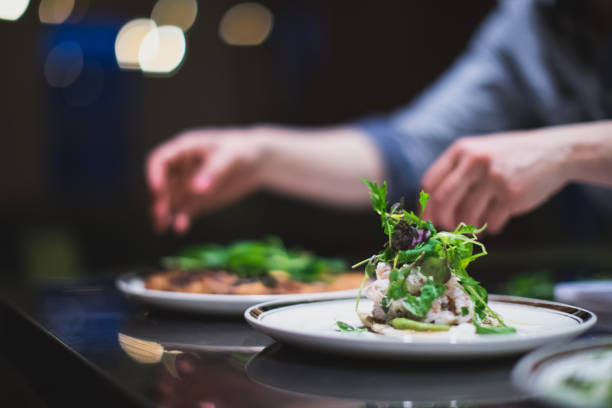Culinary Alchemy: Transforming Humble Ingredients into Gourmet Delights
Discover the art of elevating everyday ingredients into extraordinary dishes. This culinary journey explores innovative techniques and creative pairings that transform simple components into gourmet masterpieces. From reimagining pantry staples to unlocking hidden flavors, prepare to revolutionize your approach to cooking and dining.

Texture Transformation: From Ordinary to Extraordinary
Texture plays a crucial role in our perception and enjoyment of food. By manipulating the texture of ingredients, you can create entirely new dining experiences. One innovative technique is using molecular gastronomy principles to create unexpected textures, such as turning liquids into caviar-like spheres or creating airy foams from intense flavors. For a more accessible approach, try contrasting textures within a single dish. Pair creamy purees with crunchy elements, or combine smooth sauces with crispy toppings. Experiment with different cooking methods to alter textures – for example, try deep-frying herbs for a delicate, crispy garnish or using a blow torch to create a caramelized crust on fruits. Even simple ingredients like nuts can be transformed by candying, spice-coating, or pulverizing into a fine dust. By focusing on texture, you can elevate familiar ingredients into exciting new forms that surprise and delight the palate.
The Art of Flavor Pairing and Infusion
Mastering the art of flavor pairing can turn ordinary ingredients into extraordinary culinary creations. Start by exploring unexpected combinations, such as pairing fruit with savory dishes or incorporating floral notes into desserts. Herbs and spices are powerful tools for infusing unique flavors into familiar ingredients. Try infusing oils with herbs or chili peppers to create flavorful drizzles, or steep aromatics in cream for a subtly flavored base for sauces or desserts. Experiment with smoke as a flavoring agent by using a smoking gun to infuse delicate ingredients like butter or cocktails with woodsy notes. Another technique is to create flavor-packed rubs or marinades using a combination of spices, herbs, and aromatics to transform simple proteins. Don’t be afraid to cross cultural boundaries in your flavor pairings – combining techniques and ingredients from different cuisines can lead to exciting new flavor profiles that elevate your cooking to gourmet heights.
Plating and Presentation: Turning Food into Art
The visual appeal of a dish can significantly enhance the dining experience, turning a simple meal into a gourmet event. Start by thinking about color contrasts and balance on the plate. Use vibrant, fresh ingredients to create pops of color against neutral backgrounds. Experiment with different plating styles, such as deconstructed presentations or geometric arrangements. Utilize negative space on the plate to draw attention to the main elements of the dish. Incorporate edible flowers or microgreens for delicate, visually appealing garnishes. Play with height and dimension by stacking components or using unique serving vessels. Consider the texture of the plate itself – a rustic wooden board or sleek slate can complement different types of dishes. Use sauces and purees to create artistic swooshes or dots on the plate. Remember that presentation isn’t just about aesthetics – it should also enhance the eating experience by guiding the diner through the dish. By mastering these plating techniques, you can transform even the simplest ingredients into visually stunning, restaurant-worthy creations.
Reimagining Leftovers and Reducing Food Waste
Elevating humble ingredients to gourmet status isn’t just about using expensive or rare components – it’s also about creatively using what you have on hand, including leftovers. This approach not only produces delicious meals but also helps reduce food waste. Start by thinking of leftovers as ingredients rather than finished dishes. Transform day-old bread into a savory bread pudding or crispy croutons. Use leftover roasted vegetables to create a luxurious soup or blend them into a flavorful dip. Overripe fruits can be cooked down into compotes or jams, adding a gourmet touch to breakfast or desserts. Even vegetable scraps can be turned into flavorful stocks or crispy chips. Get creative with repurposing proteins – shred leftover roast chicken for tacos or turn last night’s steak into a hearty salad. By approaching leftovers with a gourmet mindset, you can create exciting new dishes that are both delicious and sustainable.
Culinary Alchemy: Tips and Tricks
-
Invest in a good quality salt and use it to finish dishes for an instant flavor boost
-
Experiment with infused oils and vinegars to add complexity to simple dishes
-
Learn the art of balancing flavors: sweet, sour, salty, bitter, and umami
-
Master the technique of deglazing to create flavorful pan sauces
-
Use a mortar and pestle to grind fresh spices for maximum flavor
-
Incorporate fermented ingredients like miso or kimchi for depth and complexity
-
Experiment with different cooking methods for the same ingredient to discover new textures and flavors
-
Learn to make compound butters to add instant sophistication to any dish
-
Use citrus zest to brighten flavors without adding extra liquid
-
Don’t underestimate the power of fresh herbs – they can elevate even the simplest dishes
In conclusion, transforming humble ingredients into gourmet delights is an art form that combines creativity, technique, and a deep understanding of flavors and textures. By mastering umami-boosting techniques, playing with textures, exploring innovative flavor pairings, perfecting presentation, and reimagining leftovers, you can elevate your cooking to new heights. Remember, true culinary alchemy isn’t about using expensive ingredients – it’s about applying skill, imagination, and passion to transform the ordinary into the extraordinary. So, embrace your inner alchemist and start turning simple components into gold in your kitchen today.





